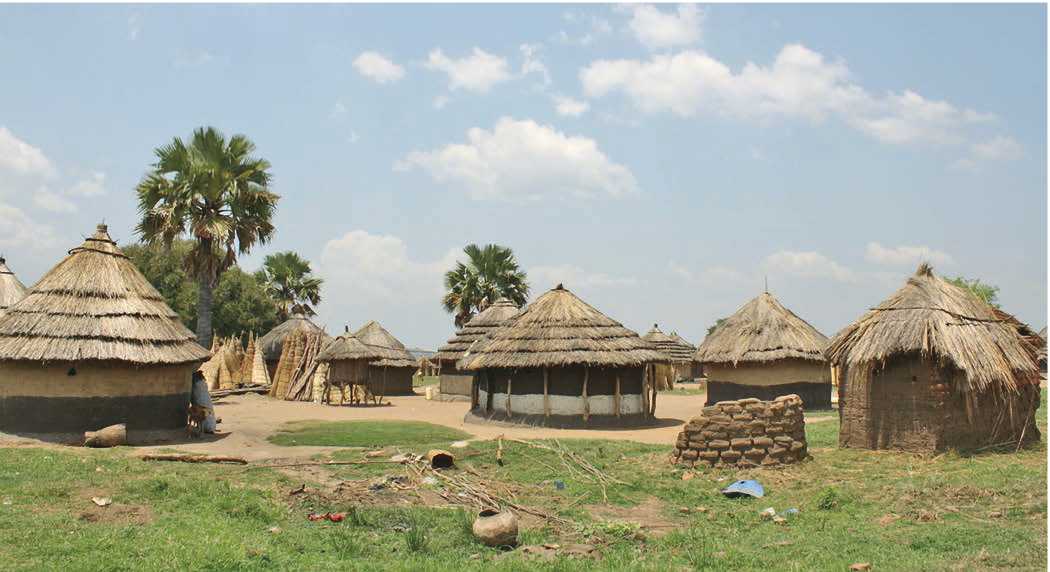The Bantu expansion was paralleled by the expansion of Nilotic-speaking people from southern Sudan. Though many remained cattle breeders, such as the Maasia, some shifted to agriculture. Among those are the Acholi, who live in northern Uganda.6 They are thought to have come to the area from southern Sudan, but are primarily agricultural in orientation. The society, however, is divided hierarchically; with each ascending level of social and political organization there is an increase in the degree to which the parts form coherent wholes. At the core there is a household. A new household comes into existence after cohabitation between a man and his first wife has been established. Until she becomes pregnant they will live as part of his mother’s family. After a child is born, the couple builds a hut of their own, taking some seeds from the woman’s mother’s home to start her own plot. Once these plants have produced their grain and she has her own granaries then the household becomes officially independent. As the man acquires more wives and dependents, the degree of his dependence on the parent households lessens. Each household then becomes the nucleus from which others develop. In the newly established household the couple will share a single hut, but after a while she moves into her own hut, which is a symbol of her status in the village and in which she keeps her possessions and cooks for the family. There are a wide variety of sizes to households; the ruler’s is by far the biggest. These difierences are significant in mapping out wealth and status.
Figure 15.13: Acholi village, Northern Uganda. Source: Juraj Ujhazy

The Acholi huts are circular and have walls built of timbered posts interlaced with thin lattice, the interstices of which are filled with mud. A strong center pole supports the lattice framework of the roof, which is covered with thatch and which overhangs the walls forming a kind of circular porch. The hut is partially divided into two between a more public front and a more private rear where there are stored the large earthen pots containing food and valuables. Prominently displayed on the wall in the hut is her apron, which she wears only when traveling or on ceremonial occasions. Cooking pots are suspended from rafters in hanging nets, and seeds for the next planting are preserved above the fire, where the smoke keeps the termites away. The fire is lit in a small trench in the floor and is allowed to go out after cooking is finished (Figure 15.13).
Cooking takes place in the front and sleeping in the rear, where there are also stored the large earthen pots containing food and valuables. Granaries that are an integral part of each household are positioned in the dye-kal, the open space of hard earth onto which the huts face. The granaries are of basketwork, plastered with mud outside and cow dung inside; they are raised from the ground on stilts of timber or on stones. Each has a roof of thatch that can be removed for access.
The wife will go in the morning to fetch water; she will then prepare a meal of millet gruel, bathe the children, and smear them with a paste made of oil and red ochre. During the cultivating season, the village will be largely deserted during most of the day except for the children and elderly. In the evening the woman prepares the meal for the men and will eat after they have finished. The primary ambition of the man is to develop grain surpluses since that enhances his status, allows him to acquire more wives, and induces kinsmen to settle near him.
Households may disintegrate through the death of their heads and the members are absorbed by sons and relatives. The village, however, remains the enduring formation since it is associated with family lineages and provides the internal environment in which the household develops. A village can be relatively difi'use in form. There are no perimeter walls or defenses. In the center of the village there is a wooden structure of rough seats raised one above the other at the bottom of which is a space for a fire. On these seats in the early morning and late evenings, all the warriors of the village collect with their chief to discuss the afi'airs of the day. To one side of the courtyard innumerable stakes are driven into the ground and to these the cattle are tethered for the night.7 One village, for example, had a population of 156 people organized into thirty-four households scattered over some 6 square miles of rolling savanna. Each village has a hunting domain and a separate land in which grain is cultivated. There is no system of artificial irrigation. All members of a village cooperate in agricultural work with males taking part in joint hunts. The traditional game was waterbuck, elephant, rhino, girafie, and bufialo.
Each household is more or less responsible for its own welfare. Surpluses are used to expand the household or to give as gifts to those higher in rank. Because of this agriculture is not considered “work,” and land is not considered part of their concept of wealth, which is instead dominated by cattle, wives, children, skins, shields, cooking pots, and utensils, in that order. This means that even though there is no concept of communal wealth, there is intense competition among households for control of the various indicators of wealth.
Each village is controlled by members of aristocratic village lineages (rwot) who are responsible for officiating at the various ceremonies, such as rain-making, sowing, and first fruit. The rwot act as arbiters settling disputes in the village. All male inhabitants of a domain are required to give tribute to the rwot, usually in the form of skin, meat, and ivory. If a group refuses to do this, it will move away to found a new domain. The numerous domains are under the authority of a chief, which is dynastic in nature. As a result, the society is neither completely centralized nor completely localized but a blend of the two.
Kin will identify themselves with a totem animal that they are obliged not to kill under fear of certain taboos. The bush buck is the totem of the kings and of other rulers of Uganda as well as of most aristocratic lineages. There are also special spirit shrines with sacred rites performed by the “fathers of the soil” who are members of the rwot. These shrines (jok) are situated high on the slopes of a mountain and might consist of a cave, a spring, a tree, or other remarkable landscape features. In some cases the jok is an impersonal spirit with no human attributes. In other cases, it is male and perhaps has a wife. Each village will also have a spirit house, in the center of which sometimes an iron spear, blade uppermost, is planted in the ground. Strangers are not permitted to enter. A stick is planted and on the branches are placed the trophies of the hunt, namely the skulls and horns of lions, leopards, and girafies. Most of these shrines have now disappeared during the process of Christianization.
The young men who are especially brave become recognized as warriors and dress in a distinctive way with an elaborate headdress in the form of a cone of hair with beads stitched into it and decorated with ostrich and parrot feathers; behind the cone a spike of ivory is fastened, curving toward the front.




 World History
World History









